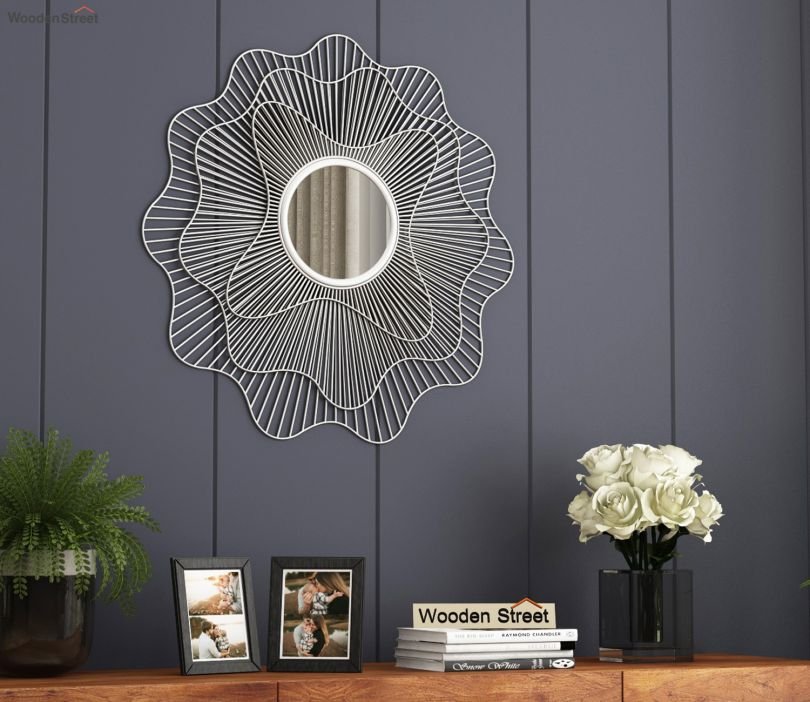Choosing the perfect wall mirror for your home is more than just picking a reflective surface—it’s about enhancing your space’s aesthetic, functionality, and ambiance. At Wooden Street, we understand that mirrors are both practical tools and stunning decorative mirrors that can transform any room. However, selecting the right size for a mirror requires careful consideration of your space, furniture, and design goals. In this guide, we’ll walk you through the key factors to consider when choosing the ideal mirror design size for various rooms in your home, ensuring a balanced and visually appealing result.
Why Mirror Size Matters
A wall mirror does more than reflect light; it can make a room feel larger, brighter, and more inviting. However, a mirror that’s too small may look out of place, while one that’s too large can overwhelm the space. The right size ensures your mirror complements the room’s proportions, furniture, and overall style. Whether you’re decorating a living room, bedroom, bathroom, or dining area, Wooden Street’s extensive collection of mirror designs offers options to suit every need.
Here are some practical tips to help you choose the perfect wall mirror size for your space.
1. Consider the Room’s Purpose
The purpose of the mirror plays a significant role in determining its size. Ask yourself: Is the wall mirror primarily for decoration, functionality, or both? For instance:
- Bathroom Mirrors: A mirror in the bathroom is typically used for grooming. It should be large enough to cover the width of the vanity or sink area. A common guideline is to choose a mirror design that is 2-4 inches narrower than the vanity to maintain balance. For double vanities, consider two smaller mirrors (24-30 inches wide each) or one long mirror (60-72 inches wide) for a cohesive look.
- Living Room Mirrors: In living rooms, a decorative mirror often serves as a focal point or enhances light. A large wall mirror (36-48 inches wide) can create a bold statement, while smaller mirrors (20-30 inches) work well as accents in a gallery wall.
- Bedroom Mirrors: A full-length mirror (at least 48-60 inches tall) is ideal for dressing, while a smaller wall mirror above a dresser (30-48 inches wide) adds elegance without overpowering the space.
- Dining Room Mirrors: A mirror design in the dining area can make the space feel more open and vibrant. Opt for a wall mirror that’s 50-75% the width of the dining table to maintain proportion.
By aligning the mirror’s purpose with its size, you ensure it enhances both functionality and aesthetics.
2. Measure Your Wall Space
Before purchasing a wall mirror, measure the available wall space carefully. This step is crucial to avoid a mirror that feels too cramped or too sparse. Use a tape measure to determine the height and width of the wall where the mirror will hang. Consider the following:
- Wall Coverage: A wall mirror should cover 50-75% of the available wall space to create a balanced look. For example, on a large living room wall, a mirror measuring 25-31 inches on each side can serve as a bold focal point without overwhelming the room.
- Clearance: Leave 4-6 inches of space above furniture like console tables or dressers to allow the mirror design to breathe. In bathrooms, position the mirror 4-6 inches above the vanity to protect it from water splashes.
- Hanging Height: The center of the mirror should be at eye level, typically 57-60 inches from the floor, to ensure it’s functional and visually appealing.
Accurate measurements help you choose a decorative mirror that fits seamlessly into your space.
3. Proportion with Furniture
When placing a wall mirror above furniture, such as a console table, dresser, or vanity, proportion is key. A mirror that’s too wide or too narrow can disrupt the room’s harmony. Follow these guidelines:
- Above Furniture: The mirror should be about two-thirds to three-quarters the width of the furniture below it. For example, a 6-foot-wide buffet table pairs well with a wall mirror that’s approximately 4 feet wide. This creates a balanced vignette while allowing space for decorative elements like lamps or vases.
- Bathroom Vanities: For a single vanity, choose a mirror design that’s slightly narrower than the vanity (e.g., a 36-inch vanity pairs with a 32-34-inch mirror). For double vanities, two mirrors or one long mirror can work, depending on the layout and lighting.
- Dining Tables: A decorative mirror above a dining table should reflect the table’s length without covering the entire wall. A mirror that’s 50-75% of the table’s width creates a balanced, elegant look.
Proportional sizing ensures your wall mirror complements the furniture and enhances the room’s aesthetic.
4. Consider the Shape and Style
The shape of your mirror design also affects how its size is perceived. Wooden Street offers a variety of mirror shapes, including round, rectangular, oval, and arched, each with unique benefits:
- Round Mirrors: These soften angular spaces and work well in modern or eclectic interiors. A small round mirror (20-24 inches) is ideal for bathrooms or entryways, while a larger one (36-48 inches) makes a bold statement in living rooms.
- Rectangular Mirrors: Classic and versatile, rectangular mirrors suit traditional or contemporary spaces. They’re perfect for bathrooms or above furniture, with sizes ranging from 24-60 inches depending on the room.
- Oval and Arched Mirrors: These add elegance and softness. An oval mirror (24-36 inches) is great for vanities or dressing areas, while an arched decorative mirror (36-48 inches) adds sophistication to dining rooms or entryways.
Choose a shape that complements your room’s style and furniture to enhance the overall mirror design.
5. Enhance Light and Space
One of the greatest benefits of a wall mirror is its ability to reflect light and create the illusion of a larger space. To maximize this effect:
- Opposite Windows: Place a mirror opposite a window to reflect natural light, making the room feel brighter and more spacious. A large decorative mirror (36-60 inches) works best for this purpose.
- Small Spaces: In compact rooms, a mirror that’s slightly larger than expected (e.g., 25-31 inches) can make the space feel more open without overwhelming it.
- Layered Lighting: Pair your mirror design with sconces or overhead lighting to enhance its reflective properties, especially in bathrooms or entryways.
By strategically sizing and placing your wall mirror, you can amplify light and create a more inviting atmosphere.
6. Customization for Unique Spaces
If your space has unique dimensions or design requirements, consider custom mirror designs from Wooden Street. Custom mirrors allow you to specify exact measurements, ensuring a perfect fit for niches, narrow walls, or oversized spaces. For example, a custom wall mirror for an awkwardly shaped hallway can be tailored to maximize light and style without compromising proportion.
Final Thoughts
Choosing the right size for your wall mirror is a blend of art and science. By considering the room’s purpose, measuring your wall space, ensuring proportional balance with furniture, selecting the right shape, and leveraging the mirror’s ability to enhance light, you can find the perfect mirror design for your home. Wooden Street’s extensive collection of decorative mirrors offers a range of sizes, shapes, and styles to suit every space, from cozy bedrooms to grand dining areas. Explore our collection today at Wooden Street and discover the ideal wall mirror to elevate your home’s ambiance.
Related Reads
- Custom Fitness App Development: Build the Fitness App Your Users Actually Want
- Discover the Best Eye Hospital in Kurukshetra: Sobti Nursing Home Excellence in Eye Care
- How quickly can Diamond Locksmiths respond to an emergency locksmith call?
- Best Consultancy in Delhi: Helping You Find Your Dream Job with Infinity Exists
- From Dust to Fresh Air: Exploring Top Indoor Air Quality Solutions in Rockville
- Quality HOA & Property Management Services for Riverside Communities



